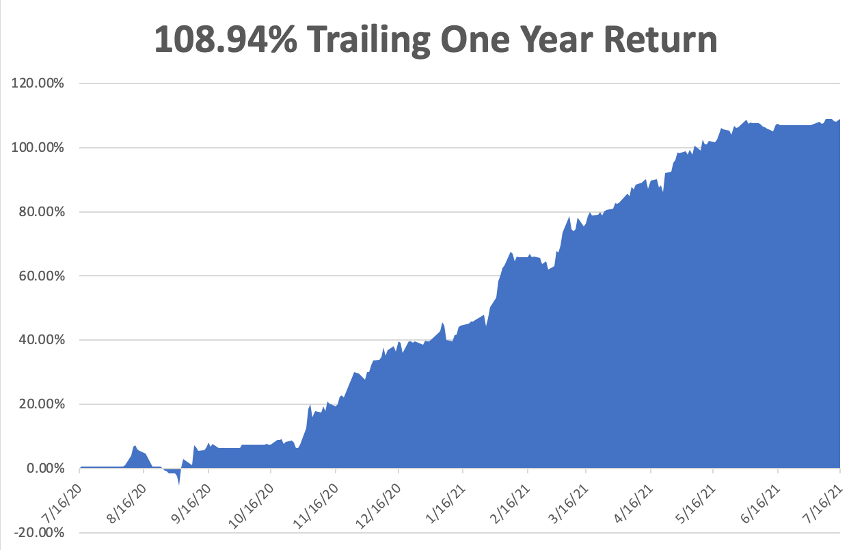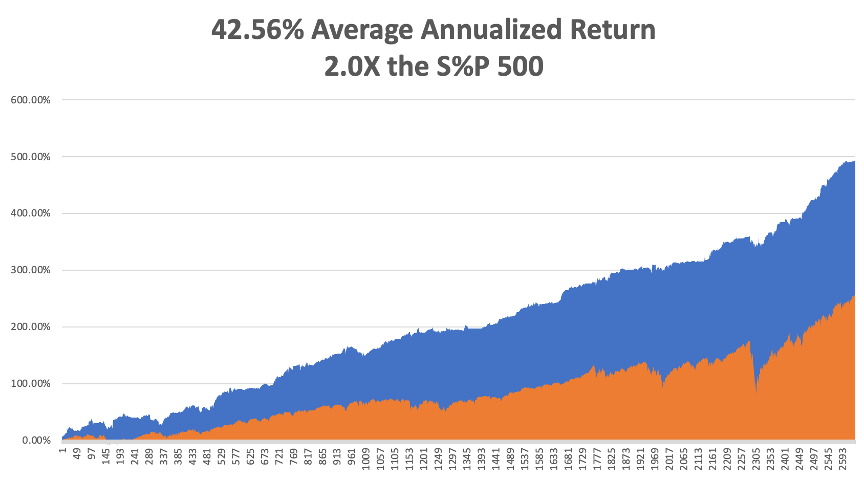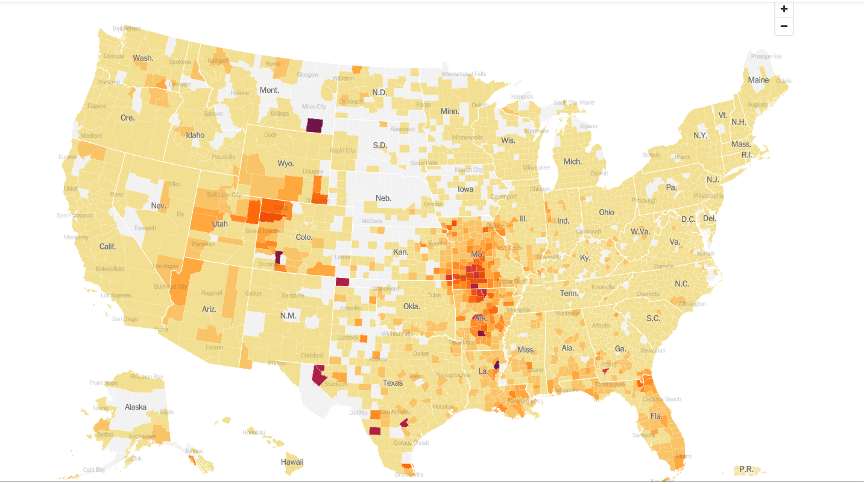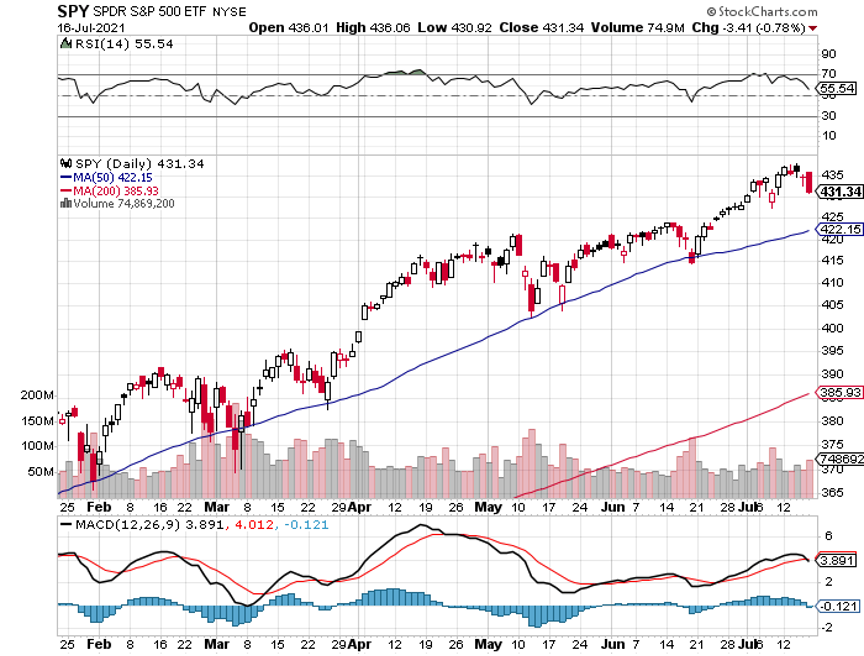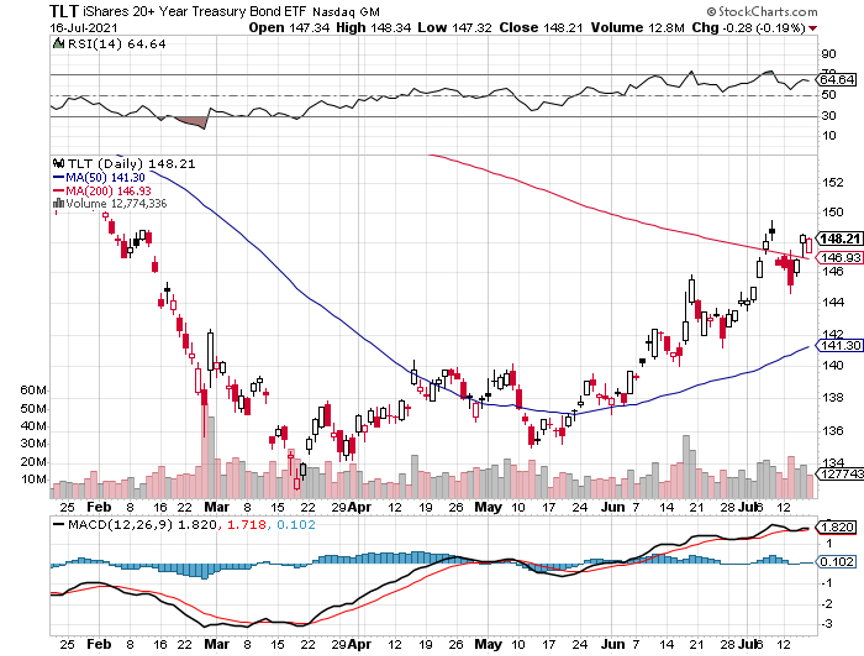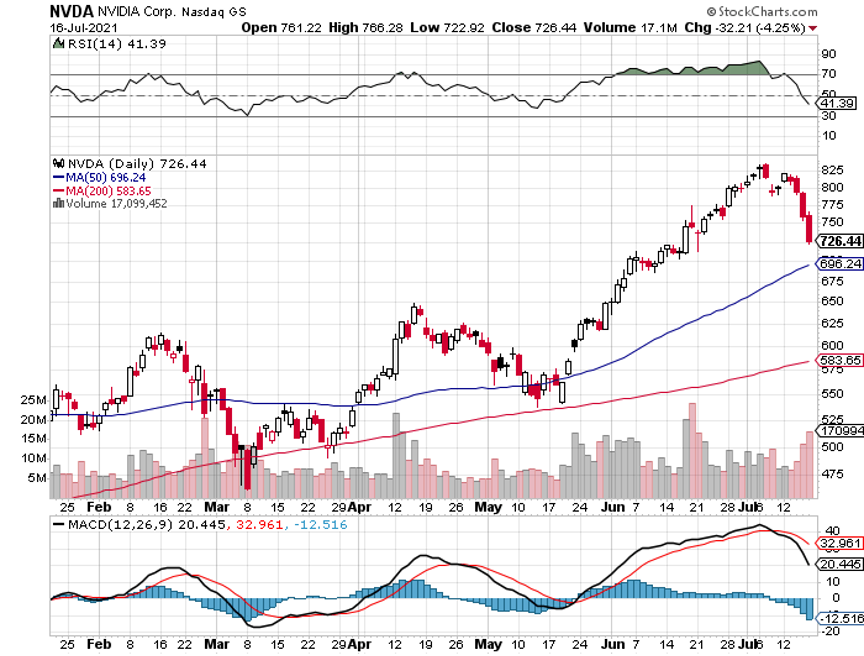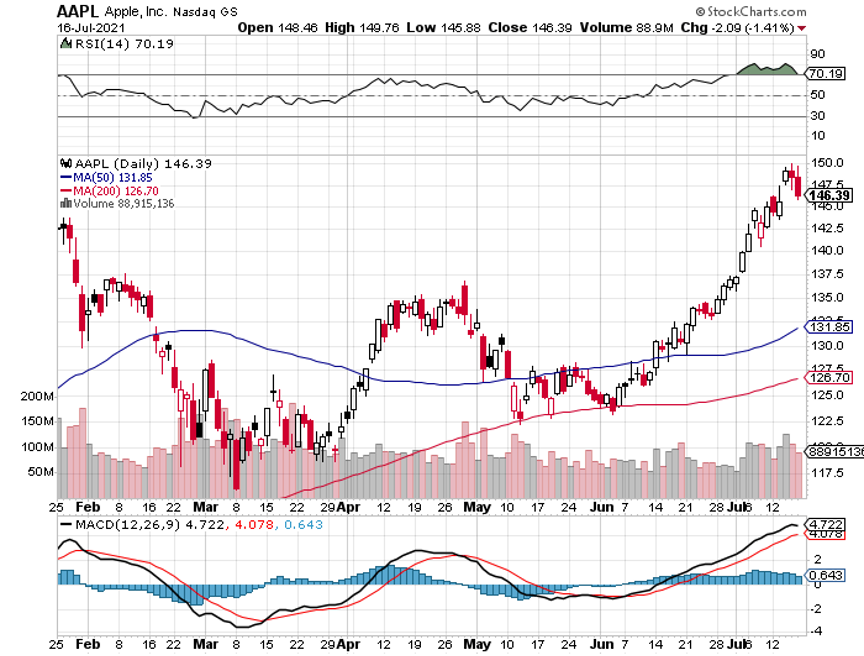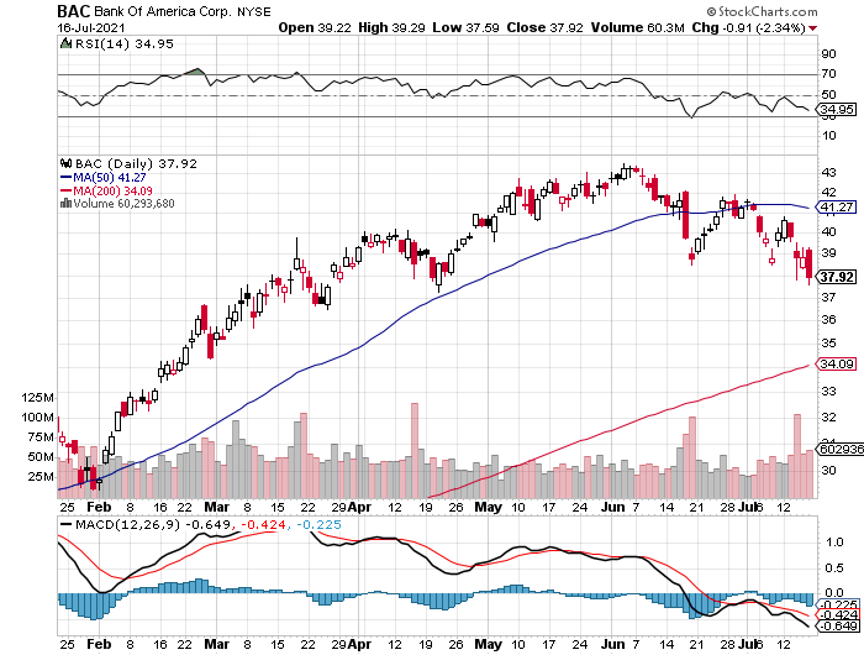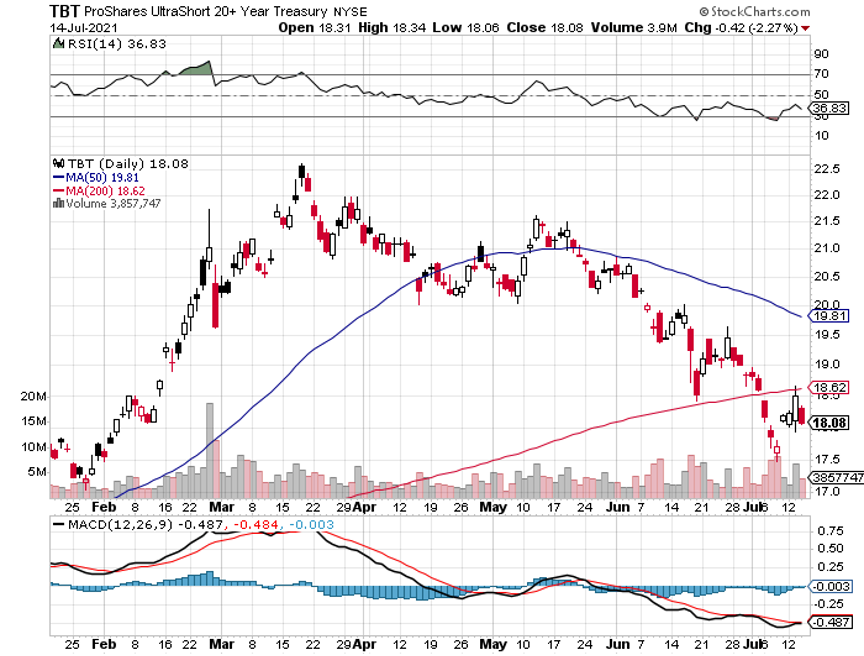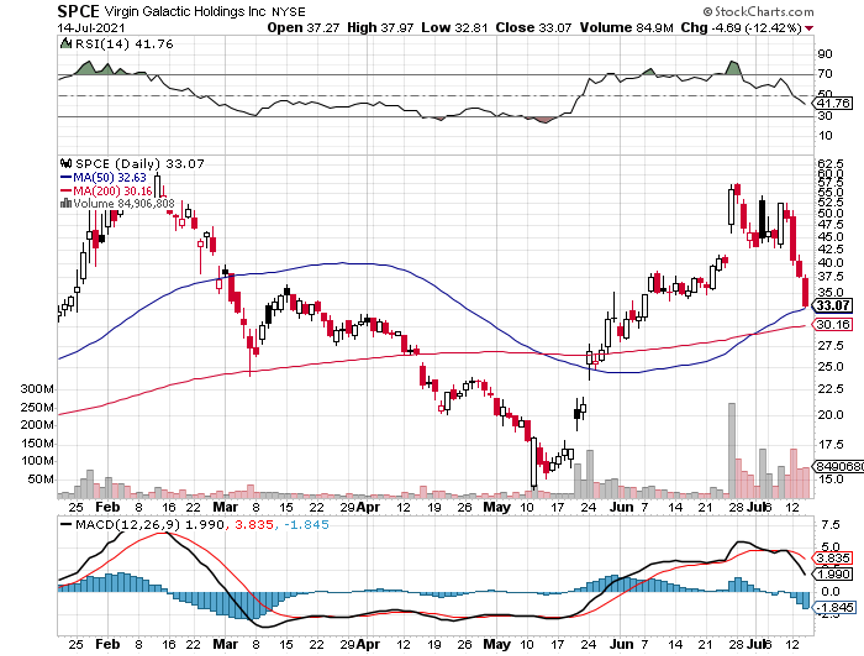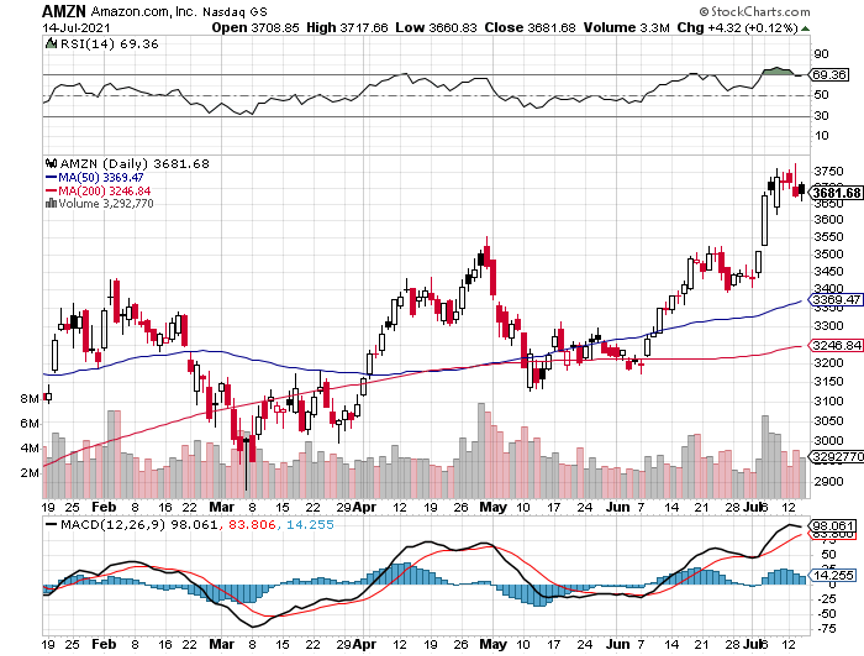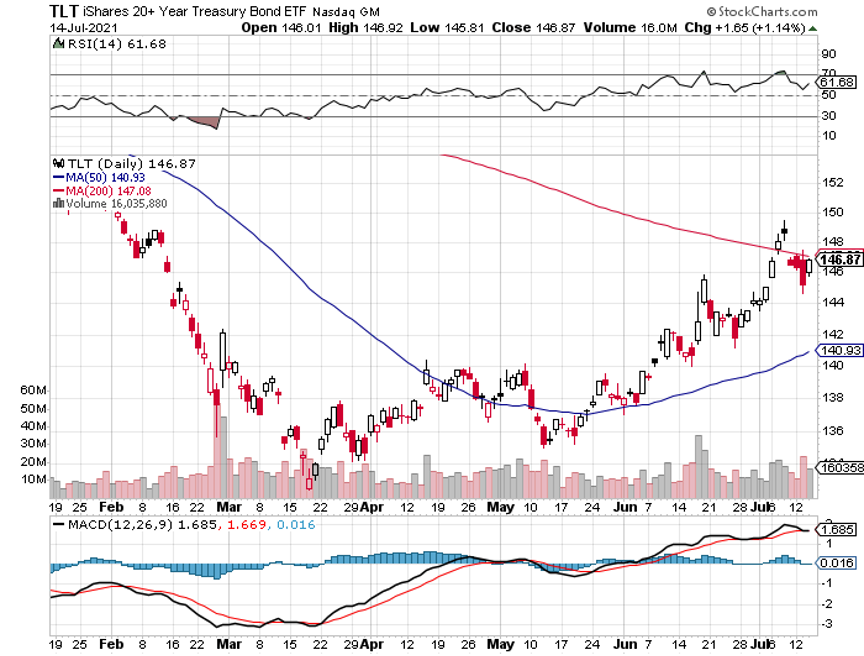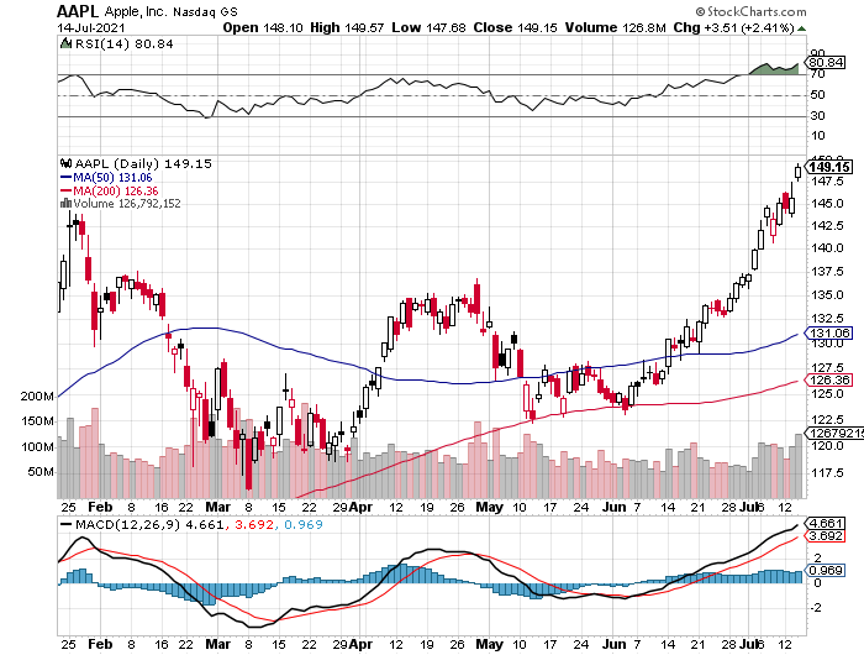“Language does not provide the means for us to describe the destruction before us,” said Chancellor Angela Merkel about the damage from the climate change-induced flooding in Germany.
Global Market Comments
July 21, 2021
Fiat Lux
Featured Trade:
(AN INSIDER’S GUIDE TO THE NEXT DECADE OF TECH INVESTMENT),
(AMZN), (AAPL), (NFLX), (AMD), (INTC), (TSLA), (GOOG), (FB)
Global Market Comments
July 20, 2021
Fiat Lux
Featured Trade:
(SHOPPING FOR FIRE INSURANCE IN A HURRICANE)
(VIX), (VXX), (XIV)
(THE ABCs OF THE VIX)
(VIX), (VXX), (SVXY)
Global Market Comments
July 19, 2021
Fiat Lux
Featured Trade:
(MARKET OUTLOOK FOR THE WEEK AHEAD, or THE DELTA CORRECTION IS HERE)
(AMZN), (AAPL), (FB), (MSFT), (TAN), (FSLR)
Right now, the fate of your investment portfolio, and indeed your life, is in the hands of a minority of anti vaxers in the Midwest.
If the surge in the delta variant burns out in weeks or a month, the current market correction won’t extend any more than 5% and you should be loading the boat with big tech stocks like (AMZN), (AAPL), (FB), and (MSFT).
The delta variant is becoming a big deal, with unvaccinated states like Arkansas (35% vaccination rate) and Missouri (40% rate) driving the resurgence. It is essentially an epidemic of the unvaccinated.
Unless checked, it could lead to a broader stock market selloff in August. Los Angeles brought back the indoor mask mandate on Saturday, although compliance is near zero. San Francisco may be close behind.
Everyone in my company worldwide is now vaccinated, with Australia last to get one. I’ll be first in line for the Pfizer booster out in the fall. Delta is twice as contagious, more fatal, with more permanent side effects than earlier variants. And it’s killing more kids.
But it’s not the delta you have to worry about. If a future epsilon or zeta variant emerges, that can overcome our current vaccines, bred in the Midwest, the economy would shut down again and you can kiss your bull market goodbye. That would lead to a 1918 style finish to this pandemic, the fatality rate would go up to 50%, and millions more would die.
I’ll stick to the optimistic case….for now.
Even if we get a new variant, we now have the infrastructure in place to sequence the DNA of a new strain in a day and have 100 million doses in the freezer in two months. But it could be a close-run thing.
If you want to stick with your long portfolio in the face of millions dying here is the argument.
The Fed is unable to stimulate the economy any further through interest rate cuts or more QE. It is like pushing on a string. Companies can’t hire the labor they need to increase production or obtain the parts to make things.
This ends in August when workers get their free childcare back in the form of the public school system. The ending of Covid benefits will also light a fire under them. This will lead to a collapse in the unemployment rate and a further rise in GDP from the current ballistic 7.0% rate. This will allow the Fed to raise rates, but not enough to hurt stocks, especially techs.
This is your Goldilocks scenario for H2.
Driving down from Lake Tahoe to Long Beach to pick up my kids from Scout Camp, I passed two huge wildfires. Half the vehicles on the road (US 395) were fire trucks and crews moving in from other states. It’s like being at war.
So, you might ask the question of when will Climate Change affect the stock market? The answer is that Climate Change is actually great for stocks. Money gets spent to put fires out, then trillions of dollars get spent to rebuild with insurance claims.
The biggest impact of climate change is the decarbonization of our energy infrastructure, out of fossil fuels and into alternatives. Solar will soar from 20% to 70% of total electric power output in a decade while nuclear stays at 20% and hydroelectric at 10%. Coal and oil completely disappear. This will enable a large cut in our total energy bill.
Yes, I know oil has rallied lately. I’m sure American Leather had rallied on the way to zero, the only Dow stock to ever completely disappear. It was wiped out by the transition from horses to cars, eliminating 97% of the demand for leather. (The horse population went from 120 million to only 3.8 million today).
There are ways to play this today. Solar growth will be massive, so you have to look at the Invesco Solar ETF (TAN) and First Solar (FSLR).
Here is the next market top, at least for the short term. That’s because, for the last year, stocks have a nasty habit of selling off after quarterly earnings reports, which are just around the corner. Announcement dates for the FANGS are below. For the short term, you want to sell days before the reports. For the long term, you want to keep them, as I expect all to double or more in the next three years.
Facebook (FB) is July 28, 2021
Alphabet (GOOGL) - Jul 25, 2021
Apple (AAPL) Jul 27, 2021
Amazon (AMZN) Jul 26, 2021
Netflix (NFLX) Jul 20, 2021
Microsoft (MSFT) - Jul 28, 2021
China’s economy is slowing, with the post-Covid bounce over. It just provided $154 billion in stimulus for its economy and cut bank reserve requirements by 50 basis points. If they slow there, we could slow here, especially for big exporters to China in the ags.
Core CPI jumps to 5.4%, the biggest gain in 13 years. Excluding food and energy, it’s the biggest print since 1991. The Fed is holding its breath that these large numbers are temporary. Used car and truck prices accounted for a third of the gain for the second month in a row. That is certainly not sustainable, or I’m going into the used car business. Tech took off like a rocket on the news.
Producer prices show biggest gain since 2008, the is index up a hot 1.0% in June against 0.8% in May. PPI is up 7.3% YOY. Higher commodity and labor costs against shrinking inventories were the big issues. Inflationary pressures are here, but for how long?
Senate agrees to $3.5 trillion spending plan, providing great news for stocks and terrible news for bonds. No Republican support is required. This is in addition to the $579 billion infrastructure deal reach with opposition support. It’s enough dosh to keep this stock market percolating for years. Buy FANGS on dips.
Any tightening is a ways off, says Fed governor Jerome Powell in his congressional testimony, sending bonds soaring. The comment was in response to the superheated 5.4% CPI print on Tuesday. The $120 billion a month in Fed bond buying continues. Big tech loved it and continued with its non-stop rally. The rocket fuel for share prices continues unabated.
The four biggest US banks deliver spectacular earnings, posting a combined $33 billion in profits, triggering the predictable selloff. That is $9 billion above analyst forecasts, which seem to be a permanent lagging indicator. Consumer spending is exceeding pre-pandemic levels, credit quality is soaring, and credit card spending is through the roof. Buy (JPM), (BAC), and (V) on dips.
US retail sales come rocketing back, with customers spending those stimulus checks hand over fist. The 0.6% gain in June came on the heels of a 1.7% drop in May. Vaccinations are driving buyers back into the stores. Electronics stores, clothing, and restaurants saw the biggest increases.
Bank of America lowers US GDP from 7.0% to 6.5%, still the whitest hot numbers in history. 2022 is looking like 5.5%, still double the pre-pandemic rate. Personally, I think these numbers are low, and the stock market thinks so too. Keep buying dips in the good names.
Investors pouring out of bonds and into stocks, according to a survey of mutual fund flows last week. I couldn’t agree more. The Fed can’t keep holding on to zero rates forever, and when their turn comes, its will be brutal.
My Ten Year View
When we come out the other side of pandemic, we will be perfectly poised to launch into my new American Golden Age, or the next Roaring Twenties. With interest rates still at zero, oil cheap, there will be no reason not to. The Dow Average will rise by 800% to 240,000 or more in the coming decade. The American coming out the other side of the pandemic will be far more efficient and profitable than the old. Dow 240,000 here we come!
My Mad Hedge Global Trading Dispatch profit reached a 1.84% gain so far in July. My 2021 year-to-date performance appreciated to 70.44%. The Dow Average is up 13.35% so far in 2021.
I spent the week running my two last positions, a long in (JPM) and a short in the (TLT) into the July 16 options expiration. Both expired at max profit. I then immediately strapped on a new short in the (SPY), my first since the pandemic began. That leaves me 90% in cash. I’m keeping positions small as long as we are at extreme overbought conditions.
That brings my 11-year total return to 492.99%, some 2.00 times the S&P 500 (SPX) over the same period. My 12-year average annualized return now stands at an unbelievable 42.56%, easily the highest in the industry.
My trailing one-year return exploded to positively eye-popping 108.94%. I truly have to pinch myself when I see numbers like this. I bet many of you are making the biggest money of your long lives.
We need to keep an eye on the number of US Coronavirus cases at 34.1 million and deaths topping 609,000, which you can find here.
The coming week will be a weak one on the data front.
On Monday, July 19 at 11:00 AM, the NAHB Housing Market Index for July is out. Johnson & Johnson (JNJ) and Verizon (VZ) report.
On Tuesday, July 20, at 8:30 AM, Housing Starts for June are printed. Haliburton (HAL) and United Airlines (UAL) report.
On Wednesday, July 21 at 11:30 AM, EIA Crude Oil Stocks are announced. Netgear (NTGR) reports.
On Thursday, July 22 at 8:30 AM, we learn the latest Weekly Jobless Claims. At 11:00 AM, we get Existing Home Sales for June. American Airlines (AAL) and Biogen (BIIB) report.
On Friday, July 23 at 2:00 PM, we learn the Baker-Hughes Rig Count. American Express (AXP) reports.
As for me, we all had to rearrange our budgets in the last year, dumping old spending habits and adopting new ones.
As for me, my electric scooter bill with Lime (click here for the site) has gone through the roof. They neatly fill the gap between walking and Uber in major tourist areas like Long Beach.
It’s a lot of fun, provided you don’t kill yourself on your first ride. The scooters go fast, some 20 miles an hour. Each one has a 13-mile range. When you’re done, you just drop it, take its picture, and then Lime picks it up and recharges it overnight.
I think I broke all seven of their mandatory rules (no driving on sidewalks, driving without a helmet, drinking while driving….). Hey, the great thing about being my age is that there are no long-term consequences to anything.
Stay healthy.
John Thomas
CEO & Publisher
The Diary of a Mad Hedge Fund Trader
Check Out My New Wheels
Here is the Problem
Global Market Comments
July 16, 2021
Fiat Lux
Featured Trade:
(JULY 14 BIWEEKLY STRATEGY WEBINAR Q&A),
(JPM), (MS), (GS), (TLT), (TBT), (CRSP), (AAPL), (TSLA), (QS), (SPCE), (AMZN),
(FCX), (FEYE), (PANW), (HACK)
Below please find subscribers’ Q&A for the July 14 Mad Hedge Fund Trader Global Strategy Webinar broadcast from Lake Tahoe, NV.
Q: Which banks are best?
A: JP Morgan (JPM), Morgan Stanley (MS), and Goldman Sachs (GS). That's the trifecta. If you look at the charts, the brokers Morgan Stanley and Goldman Sachs are overwhelmingly outperforming everyone else. They will continue to do that, as the bull market in stocks is a money machine for them.
Q: What has caused interest rates to continue to drop so much in the last 1-2 months? Why are you confident you will see them rise from here on?
A: The reason they've dropped so much is there is a bond shortage (TLT). There is more demand for bonds and reach for yield around the world than the US government is able to supply. Therefore, the US government should do more borrowing and issue more bonds. That's what the market is telling them to do. When your 10-year yield goes to 1.2%, the message is that you're not borrowing enough, not that you're borrowing too much. How does this end? Eventually, the sheer volume of bond issuance will reach global demand. And we will also see some inflation, not much but some, and that will be enough to take us back up to the 1.75% yield that we had in March. I think we will see that by the end of the year, especially if the Fed tapers and cuts back at least the mortgage bond purchases, which is $40 billion/month. Why subsidize housing when there are nationwide bidding wars?
Q: Are you positive on CRISPR Technologies (CRSP)?
A: Yes, but it is a long-term play and I recommend the LEAPS on those that go out to 2023. That said, we did just have a big rally up to the 140s from the 100s so that 40% was pretty good. But that's the way these small biotech’s trade you get long periods of no movement and then sudden explosive moves to the upside when they make a breakthrough.
Q: Are we going to see inflation?
A: We will have some inflation; but the major component of inflation now is used cars and rental cars, which are up 100% year on year, and that is totally unsustainable. That means a year from now, increase in used car prices will be zero, and will actually be a big drag on inflation. So that's what the Fed means when they say that any inflation will be temporary as we go through these tremendous YOY comparisons when demand goes from zero to near infinite. And that's happening in many sectors of the economy right now. You never get rich betting against a 40-year trend, and for inflation that is down.
Q: Has the market peaked for the short term?
A: My bet on a short-term peak is the last week of July when all the big tech companies report. And then we classically get reasonable selloffs after that—buy the rumor, sell the news. That's our next entry point for long positions in this market. Since the presidential election, the index has been unable to drop more than 4.8% as there is so much money on the sidelines trying to get in.
Q: Should I be max long ProShares Ultra Short Treasury Bond Fund (TBT) LEAPS?
A: Just make sure they’re long-dated LEAPS—at least six months to a year or longer. That way you have plenty of time for them to work. The current return on the (TBT) June 2022 $17-$19 vertical bull call LEAPS at $0.75 is 166%.
Q: What’s the chance of Biden’s budget passing?
A: 100%. It’s just a question of how much will be in there—we’re at $597 billion on infrastructure and $3.5 trillion for the rest of spending. That gives you a $4.1 trillion budget for the next fiscal year starting October 30, which is the biggest in history and biggest since WWII on an inflation-adjusted basis. That will go through and keep the stock market percolating for several more years. Dow $240,000 here we come!
Q: Would you sell calls against Apple (AAPL) today?
A: I would, I would do something like the August $165’s. Even then, it’s a high-risk trade because Apple has been on such a parabolic move for the last 2 months. So do that at your own risk; notice I’m not putting out trade alerts telling you to short Apple in any way shape or form. My target for the yearend is $200.
Q: Will Tesla (TSLA) use QuantumScape (QS) batteries to make their own solid-state ones?
A: Tesla will make their own solid-state batteries They are far ahead of QuantumScape with their own technology and eventually, they will wipe them out. So, I am not recommending QuantumScape—they are 10 years behind Tesla. Sorry, I didn’t make that clearer in my research piece.
Q: When do you expect the 7% drop in the market?
A: August/September is usually when the market bottoms. Let’s see if we get it this time. Predicting down moves has been somewhat of a fool's errand in a market when you have infinite QE, infinite fiscal stimulus, infinite monetary stimulus, and the highest economic growth in history. And again, I am upgrading my 10-year forecast for the market; I’m not looking for a Dow 120,000 by 2030 anymore, I’m looking for a Dow 240,000, and when you’re still at only a measly 34,933, you don’t get many 7% drops. In fact, we’ve had none since the election.
Q: Could Tesla make an all-time high by the end of the year?
A: Yes, especially if they make progress on the solid-state batteries. Tesla (TSLA) tends to have sideways periods that can last years and then explosive moves to the upside. It almost trades like a biotech stock.
Q: Is Virgin Galactic (SPCE) a buy here off the back of their successful rocket launch last week?
A: No, any business dependent on retail sales of tickets at $250,000 each has absolutely no chance of ever making a profit in its life. As much as I like Richard Branson, who I used to fly with, the fact is that this business will never make money. It's more of a public relations vehicle for all of the hundreds of Virgin Brands. They’ll never get the cost low enough to make this economic for the average person. Spaceships aren’t cheap, and they don’t sell them at Costco. In fact, you notice that after the rocket launch, the stock dropped 20%. However, if they do drop the price to $100,000 even I might buy a ticket but only if they let me fly the thing.
Q: What is your favorite FANG stock other than Apple?
A: It is Amazon (AMZN). I think it hits $5,000 by the end of the year. If they try to break it up it’ll be worth $10,000, which it will get to eventually (in like 5 years) anyway. They just have absolutely everything working there.
Q: Why is Alaska the worst state to do business in?
A: Well, first of all, it’s only habitable for like 6 months of the year, and otherwise it’s too cold and heating bills are enormous. Also, nothing is produced in Alaska besides tourism and oil, which is subject to enormous volatility. They actually canceled the oil payouts for Alaskan citizens last year. Anything else you want to do in Alaska requires transportation costs from the US. So essentially there are 49 other better states to bring business ideas to.
Q: Will Amazon ever split their stock?
A: No, there's no reason or net benefit to it. Jeff Bezos has never been prone to financial engineering because he never needed to. Natural earnings growth was always so enormous he didn’t need to bother with any of these side games to jack the stock price. So, I would say “no” on a stock split.
Q: In a two-year LEAPS, you’re taking a long position, yes?
A: When you do a LEAPS spread, you're buying a 1-2 year call and you’re selling short a 1-2 year call against it. That cuts your price by ⅔ and increases your leverage by a factor of 3 and is a far greater risk/reward than just buying the 2-year call outright. If you want to learn more about LEAPS, send us an email about the Mad Hedge Concierge Service that is by application only.
Q: When is the recording up?
A: About two hours.
Q: Do you still love Freeport McMoRan (FCX)?
A: Yes, it’s taking the inflation vacation right now with the rest of the commodities, but I expect it to come roaring back by the end of the year. Electric vehicles need 200 pounds of copper compared to only 20 pounds for internal combustion cars.
Q: Thoughts on FireEye (FEYE)?
A: Yes, we love FireEye along with the rest of the cybersecurity plays, so buy on the dips. Hacking is a growth market and will never go out of fashion. BUY (PANW) and (HACK) on dips.
To watch a replay of this webinar with all the charts, bells, whistles, and classic rock music, just log in to www.madhedgefundtrader.com, go to MY ACCOUNT, click on GLOBAL TRADING DISPATCH or TECHNOLOGY LETTER, then WEBINARS, and all the webinars from the last ten years are there in all their glory.
Good Luck and Stay Healthy.
John Thomas
CEO & Publisher
The Diary of a Mad Hedge Fund Trader
Global Market Comments
July 15, 2021
Fiat Lux
Featured Trade:
(THE BULL CASE FOR BANKS)
(JPM), (BAC), (C), (WFC), (GS), (MS)
Global Market Comments
July 14, 2021
Fiat Lux
Featured Trade:
(TEN TECH TRENDS DEFINING YOUR FUTURE, or THE BEST TECH PIECE I HAVE EVER WRITTEN)
(TSLA), (GOOG), (AMZN), (AAPL), (CRSP)
Not a day goes by without a reader asking me what is the next stock ten, hundred, or thousand bagger. After all, I nailed the 295X move in Tesla (TSLA) starting in 2010.
Can’t I do better?
Well actually, I can, which is the purpose of the Diary of a Mad Hedge Fund Trader. There are many potentially Google (GOOG), Amazon (AMZN), and Apple (AAPL)-sized opportunities out there today. It’s just a matter of time before they become public and investable.
One thing I will tell you today is that they will have some or all of the following gale-force tailwinds below. These will turbocharge the value of everything you own now, as well as anything new you might pick up going forward.
The future is happening fast!
1) People are Getting Richer, as the middle-income population continues to rise worldwide. That means more customers for everything and astronomically greater earnings for the companies inventing and selling them. Everyday goods and services (finance, insurance, education, and entertainment) are being digitized and becoming fully demonetized, available to the rising billion on mobile devices. Thank the convergence of high-bandwidth and low-cost communication, ubiquitous AI on the cloud, growing access to AI-aided education, and AI-driven healthcare.
2) And they are Communicating with Each Other More. The deployment of both licensed and unlicensed 5G, plus the launch of a multitude of global satellite networks (Starlink, OneWeb, Viasat, etc.), allow for ubiquitous, low-cost communications for everyone, everywhere, all the time––not to mention the connection of trillions of devices. And today’s skyrocketing connectivity is bringing online an additional 3 billion individuals, driving tens of trillions of dollars into the global economy and into the pockets of shareholders. Thank the convergence of low-cost space launches (Space-X), hardware advancements, 5G networks, artificial intelligence, a new generation of materials science, and exponentially surging computing power.
3) Your Lifespan Will Increase by at Least Ten Years. A dozen game-changing biotech and pharmaceutical solutions (currently in Phase 1, 2, or 3 clinical trials) will reach consumers this decade as covered by the Mad Hedge Biotech & Healthcare Letter (click here for the link). Technologies include stem cell supply restoration, senolytic or age-related medicines, a new generation of Endo-Vaccines, GDF-11, and supplementation of NMD/NAD+, among several others. And as machine learning continues to mature, AI is set to unleash countless new drug candidates, ready for clinical trials. Thank the convergence of genome sequencing, CRISPR technologies (CRSP), AI, quantum computing, and cellular medicine.
4) More Capital for Everything Will Become Abundant. Over the past few years, humanity hit all-time highs in the global flow of seed capital, venture capital, and sovereign wealth fund investments. It is expected to continue its overall upward trajectory. Capital abundance leads to the funding and testing of "crazy" entrepreneurial ideas, which in turn accelerate innovation. Already, $300B in crowdfunding is anticipated by 2025, democratizing capital access for entrepreneurs worldwide. And even during a pandemic (2020), the world deployed more venture capital than ever before, handily beating out the last high-water mark in 2019. Thank global connectivity, dematerialization, demonetization, and democratization.
5) Distribution is Becoming Vastly Easier. The combination of Augmented Reality (yielding Web 3.0, or the Spatial Web) and 5G networks (offering lighting fast 100Mb/s - 10Gb/s connection speeds) will transform how we live our everyday lives, impacting every industry from retail and advertising, to education and entertainment. Consumers will play, learn and shop throughout the day in a new intelligent, virtually overlaid world. This is where technologies like SpatialWeb.net, Vatoms (new digital connections between products and customers), and Apple’s (AAPL) next generation AR & VR headsets will shine. Thank hardware advancements, 5G networks, artificial intelligence, materials science, and surging computing power.
(6) Everything is Getting Smarter: The price of specialized machine learning chips is dropping rapidly with a rise in global demand. Imagine a specialized $5 chip that enables AI for a toy, a shoe, a kitchen cabinet? Combined with the explosion of low-cost microscopic sensors and the deployment of high-bandwidth networks, we’re heading into a decade wherein every device becomes intelligent. Your child’s toy remembers her face and name. Your kid's drone safely and diligently follows and videos all the children at the birthday party. Appliances respond to voice commands and anticipate your needs. Thank AI, 5G networks, and more advanced sensors.
(7) Artificial Intelligence is Getting Smarter than We are. Artificial intelligence will reach human-level performance this decade (by 2030). Through the 2020s, AI algorithms and machine learning tools will be increasingly made open source, available on the cloud, allowing any individual with an internet connection to supplement their cognitive ability, augment their problem-solving capacity, and build new ventures at a fraction of the current cost. Thank global high-bandwidth connectivity, neural networks, and cloud computing. Every industry, spanning industrial design, healthcare, education, and entertainment, will be impacted.
(8) AI is Becoming a Service: The rise of “AI as a Service” (AIaaS) platforms will enable humans to partner with AI in every aspect of their work, at every level, in every industry. AI will become entrenched in everyday business operations, serving as cognitive collaborators to employees—supporting creative tasks, generating new ideas, and tackling previously unattainable innovations. In some fields, partnership with AI will even become a requirement. For example: in the future, making certain diagnoses without the consultation of AI may be deemed malpractice. And try trading stocks today without AI behind you. Thank increasingly intelligent AI, global high-bandwidth connectivity, neural networks, and cloud computing.
(9) Software Will Become an Integrated Part of Our Lives. As services like Alexa, Google Home, and Apple Homepod expand in functionality, such services will eventually travel beyond the home and become your cognitive prosthetic 24/7. Imagine a secure software shell that you give permission to listen to all your conversations, read your email, monitor your blood chemistry, etc. With access to such data, these AI-enabled software shells will learn your preferences, anticipate your needs and behavior, shop for you, monitor your health, and help you problem-solve in support of your mid- and long-term goals. Thank increasingly intelligent AI, neural networks, and cloud computing.
(10) Energy Will Become Effectively Free when compared to today’s all-in costs. Continued advancements in solar, wind, geothermal, hydroelectric, small nuclear, and localized grids will drive humanity towards cheap, abundant, and ubiquitous renewable energy. The price per kilowatt-hour will drop below 1 cent for renewables, just as storage drops below a mere 3 cents per kilowatt-hour, resulting in the elimination of fossil fuels globally. And as the world’s poorest countries are also the world’s sunniest, the democratization of both new and traditional storage technologies will grant energy abundance to those already bathed in sunlight. We are also on the cusp of many breakthroughs in fusion power at nearby Lawrence Livermore Labs as capital, new materials, and entrepreneurs pour in this arena. Thank materials science, hardware advancements, AI/algorithms, and improved battery technologies.
I just thought you’d like to know.
Legal Disclaimer
There is a very high degree of risk involved in trading. Past results are not indicative of future returns. MadHedgeFundTrader.com and all individuals affiliated with this site assume no responsibilities for your trading and investment results. The indicators, strategies, columns, articles and all other features are for educational purposes only and should not be construed as investment advice. Information for futures trading observations are obtained from sources believed to be reliable, but we do not warrant its completeness or accuracy, or warrant any results from the use of the information. Your use of the trading observations is entirely at your own risk and it is your sole responsibility to evaluate the accuracy, completeness and usefulness of the information. You must assess the risk of any trade with your broker and make your own independent decisions regarding any securities mentioned herein. Affiliates of MadHedgeFundTrader.com may have a position or effect transactions in the securities described herein (or options thereon) and/or otherwise employ trading strategies that may be consistent or inconsistent with the provided strategies.







